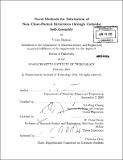Novel methods for fabrication of non-close-packed structures through colloidal self-assembly
Author(s)
Sharma, Vyom
DownloadFull printable version (20.50Mb)
Other Contributors
Massachusetts Institute of Technology. Dept. of Materials Science and Engineering.
Advisor
Yet-Ming Chiang and W. Craig Carter.
Terms of use
Metadata
Show full item recordAbstract
Colloidal dispersions are usually stabilized by interparticle electrostatic repulsion. However, strong electrostatic potentials prevent nucleation of new structures. When the electrostatic potential is strongly attractive, particles coagulate into a disordered structure; if it is strongly repulsive, known processes can order them into a closepacked structure. Driven by the need to make tailored structures, researchers have focused on circumventing electrostatics to nucleate and stabilize newer structures. Yet most colloidal systems of interest are strongly charged. Reducing the electrostatic potential of a system may create only unstable structures without long-range order. In this thesis, electrostatic interaction between strongly charged particles is exploited to make novel structures. It is shown that -with an added steric component in the interaction potential- oppositely charged particles, which undergo rapid coagulation otherwise, can be arranged into stable, long-range ordered structures. Compared to their like-charged counterparts, these structures have greater stability due to an attractive electrostatic potential. It is shown that an entire class of surfactants, amphiphilic non-ionic surfactants, can be used to stabilize an oppositely charged particle system. Stabilizing these systems, allows for the nucleation of newer structures. For instance, it is shown that a non-close-packed arrangement of positive particles can be obtained on a layer of negatively charged particles. Creating such non-close-packed 2D structures on a template is essential for creating 3D non-closepacked structures. Indeed, it is shown that at high Debye lengths, by varying the concentration of particles in a suspension of like-charged colloids, electrostatic repulsion among particles can stabilize "sparse" structures. In these structures, particles occupy only a few of the many sites that are available to them. Yet, they form an ordered structure. Nuclei of a sparser structure are assembled at higher Debye length and lower particle concentration. Monte Carlo simulations confirm that these structures are stabilized by electrostatic repulsion when particle concentration is low. It is shown that the remaining sites in a sparse structure can be filled by a different particle type. By replicating this process of 2D heterostructure formation, layer by layer, and removing one kind of particle in the last step of the process, a two-layer non-close-packed structure is obtained.
Description
Thesis (Ph. D.)--Massachusetts Institute of Technology, Dept. of Materials Science and Engineering, 2010. Cataloged from PDF version of thesis. Includes bibliographical references (p. 141-154).
Date issued
2010Department
Massachusetts Institute of Technology. Department of Materials Science and EngineeringPublisher
Massachusetts Institute of Technology
Keywords
Materials Science and Engineering.